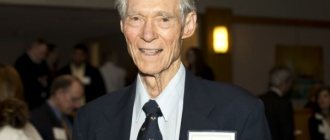Approaches to understanding the term “consciousness”
At various times, consciousness has acted as a type of mental state or as a way of perceiving and relating to others. It is often described as a point of view, as "I". Many researchers consider this category as the most important thing in the world. On the other hand, many of them tend to define the concept of “consciousness” too vaguely.
Definition 2
Consciousness is a state of mental life of an individual, which is expressed through the subjective experience of events in the external world and the life of the person himself. It is a form in which objective reality is reflected with the help of the human psyche.
Are you an expert in this subject area? We invite you to become the author of the Directory Working Conditions
In accordance with the cultural-historical approach, a characteristic feature of consciousness is represented by the fact that the intermediate link between objective reality and consciousness includes elements of social and historical practice. All this makes it possible to build objective (generally accepted) pictures of the world.
In Russian psychology, a generally accepted understanding of consciousness has been formed as the highest form of the psyche, emerging in human society with the advent of collective work, communication, language and speech. This principle was set out in their works by S. L. Rubinshtein, E. V. Shorokhov, A. N. Leontyev.
Consciousness and self-awareness.
Self-awareness, according to I.M. Sechenov, is a reflection of the act of one’s own consciousness. Self-awareness allows a person not only to reflect the outside world, but, having distinguished himself in this world, to cognize his inner world, experience it and relate to himself in a certain way.
Psychology bookap
Awareness of oneself as a certain stable object presupposes internal integrity, the constancy of the personality, which, regardless of changing situations, is able to remain itself.
Self-awareness is formed in the process of interaction with other people and is associated with self-evaluation, which depends on the success of a person’s activities.
The main function of self-awareness is to make the motives and results of his actions accessible to a person and provide an opportunity to understand what he really is and to evaluate himself. If the assessment turns out to be unsatisfactory, the person can either engage in self-improvement or, with the help of defense mechanisms, eliminate this unpleasant information from consciousness.
Literature.
1. Ananyev B. G. Towards the formulation of the problem of the development of children's self-awareness. //Fav. psychol. works. - M.: Pedagogy, 1980.
Psychology bookap
2. Zinchenko V. P., Morgunov E. B. Developing man. Essays on Russian psychology. - M., 1994.
3. Sokolova E. T. Self-awareness and self-esteem in personality anomalies. - M., 1989.
4. Chesnokova I. I. The problem of self-awareness in psychology. - M., 1977.
Consciousness in psychology
The essence of consciousness is usually defined through a person’s ability to abstract (verbal) thinking. Its tool and means is language, which arose in human society. Through language, knowledge of the laws of nature and society occurs.
Note 1
L. S. Vygotsky wrote that consciousness is a reflection of reality by the subject, his determination of his activities and himself. Consciously, according to the researcher, that which can be transmitted as a stimulus to other reflex systems (that which is capable of causing a response in them).
Finished works on a similar topic
Course work Consciousness as a subject of psychology 490 ₽ Abstract Consciousness as a subject of psychology 260 ₽ Test work Consciousness as a subject of psychology 210 ₽
Receive completed work or specialist advice on your educational project Find out the cost
Individual consciousness exists only in the presence of social consciousness and language, which is its real substrate. Consciousness did not exist initially, it is not generated by nature, but arises due to the existence of society. For this reason, consciousness is not always a postulate or a condition of psychology, but represents its problem (the subject of specific scientific and psychological research).
Vygotsky's elements of consciousness include verbal meanings as a system that operates as a whole. This working system represents the state of wakefulness, the specific human characteristic of being awake.
From the position of B. G. Ananyev, consciousness can act as an element of the effect of action. The initial facts of consciousness are the following components:
- Perception,
- An individual's experience of the results of his own actions.
Gradually, not only the effects of actions, but also the processes of activity themselves become amenable to awareness. Individual development of consciousness occurs through the transition from consciousness of the corresponding moments of action to purposeful and planned activity. The state of wakefulness is considered to be a continuous “flow” that switches from one type of activity to another.
The principle of the unity of consciousness and activity.
The principle of the unity of consciousness and activity is one of the fundamental principles of Soviet psychology. It was first formulated by S. L. Rubinstein in 1933: “...The mental properties of the individual and his behavior, consciousness and human activity are included as links, as parties in a single process in which cause and effect continuously change places. This is for us the true meaning of the position about the unity of consciousness and activity."
26
.
26 Rubinstein S. L. The problem of activity and consciousness in the system of Soviet psychology. //Scientific notes of Moscow State University. Vol. 90. Psychology. Movement and activity. - 1945. P. 12.
This problem was later developed in the works of A. N. Leontyev, A. V. Zaporozhets, B. G. Ananyev and others. According to their research and conclusions, the psyche and consciousness represent the motivating, regulating, orienting and controlling part of activity; the activity itself is the unity of two mental components: reflective-motivational (internal) and executive (external).
V. P. Zinchenko and E. B. Morgunov give a different picture of the complex relationship between consciousness and activity: “Living movement generates action, action generates self-consciousness, self-consciousness generates activity, activity generates consciousness, consciousness generates free action, free action generates personality, personality generates new types of activity, expands consciousness itself... In any case, when transformed forms enter into other broader structures or act autonomously, there are living contradictions between them, acting simultaneously as points of growth and as driving forces of development. Their unity is only moments in their existence. From this point of view, any long-term unity of consciousness and activity is the death of both. We are no longer talking about the fact that each of the transformed forms also has its own complex structure. The balance and harmony between its components is continuously disrupted by the openness of the transformed form to the environment, to the influence of other forms. Hence the crises, explosions, catastrophes (often purifying) in a person’s life, in his consciousness and activity. In psychological language, this often sounds like affects, dramas, and tragedies. Even when equilibrium is maintained, it is not static, it is not stable, it is disrupted, it has a dynamic character... Finally, each of the transformed forms has its own laws of development, including spontaneous ones. The source of development is the heterogeneity of both the original natural forms (for example, living movement) and the transformed forms arising on their basis. Understanding mental development and human development as the generation of transformed forms is a challenge to modern psychology from the philosophy of culture and civilization.”
27
.
27 Zinchenko V. P., Morgunov E. B. A developing person. Essays on Russian psychology. - M., 1994.
On the spontaneity of consciousness, see:
1. Mamardashvili M.K. How I understand philosophy. - M., 1980.
Psychology bookap
2. Mamardashvili M.K. Consciousness as a philosophical problem. //Questions of Philosophy - 1990. - No. 10.
3. Nalimov V.V. Spontaneity of consciousness. - M., 1980.
Structure of consciousness.
L. Feuerbach put forward the idea of the existence of consciousness for consciousness and consciousness for being. This idea was developed by L.S. Vygotsky.
Psychology bookap
A. N. Leontiev identified three components in the structure of consciousness:
* sensual fabric of the image;
* meaning;
Psychology bookap
* meaning.
V. P. Zinchenko adds another component to this structure: the biodynamic fabric of movement and action. Then we can imagine the structure of consciousness schematically as follows:
Another version of the structure of consciousness is proposed by F. E. Vasilyuk28.
28 Vasilyuk F. E. The structure of the image. //Question psychol. - 1993. - No. 5.
Literature.
1. Antsyferova L.I. The principle of connection between the psyche and activity and the methodology of psychology. //Methodological and theoretical problems of psychology. /Ed. E. V. Shorokhova. - M.: Nauka, 1969.
2. Leontyev A. N. Activity. Consciousness. Personality. - M.: MSU, 1975.
Emergence
When did psychology emerge as a science of consciousness?
The term “consciousness” appeared in the works of ancient philosophers.
But only at the end of the 19th century, researcher V. Wund proposed using it as a subject of psychology . Thus begins a new direction, psychology as the science of consciousness.
V. Wund became the founder of classical psychology of consciousness, combining the ideas and achievements of his predecessors in this field. It was he who managed to organize a holistic scientific psychological school.
The essence of this direction is that the phenomena of this act cannot be reduced to physical stimuli affecting the subject. Mental life is distinguished by the presence of original causes.
Gradually narrowing the class of mental processes, representatives of this direction were able to discover a number of important laws of the functioning of the psyche.
Thus, the direction under consideration ultimately acted as the basis for identifying psychology as an independent discipline.
How to communicate with the subconscious? Read about it here.
Consciousness and unconsciousness.
In the zone of clear consciousness, only very few signals from the internal and external environment are reflected. At a given moment in time, those objects that create obstacles to the normal continuation of behavior regulation or, for other reasons, are significant for a person are realized. Difficulties or significant stimuli that arise attract attention and are thus recognized. After finding a new way to regulate or solve a difficult situation, control is again transferred to the subconscious.
Thus, the so-called secondary automatisms (walking, running, professional skills, etc.) belong to the sphere of the subconscious. The sphere of the subconscious also includes mental phenomena that have a subjective component that has not yet become consciousness (the psyche of infants, the drowsy state of an adult, the post-syncope state, etc.). The most interesting is that part of the subconscious that was developed in the teachings of S. Freud. Freud believes that the unconscious is not so much those processes to which attention is not directed, but rather experiences suppressed by consciousness, those against which consciousness erects powerful barriers.
Literature.
1. Freud Z. Introduction to psychoanalysis. Lectures. - M.: Nauka, 1989.
Psychology bookap
2. Freud Z. Psychopathology of everyday life. //Psychology of the unconscious. - M.: Education, 1990.
3. Freud Z. I and It. //Psychology of the unconscious. - M.: Education, 1990.
4. Shertok L. The unknown in the human psyche. - M., 1982.








